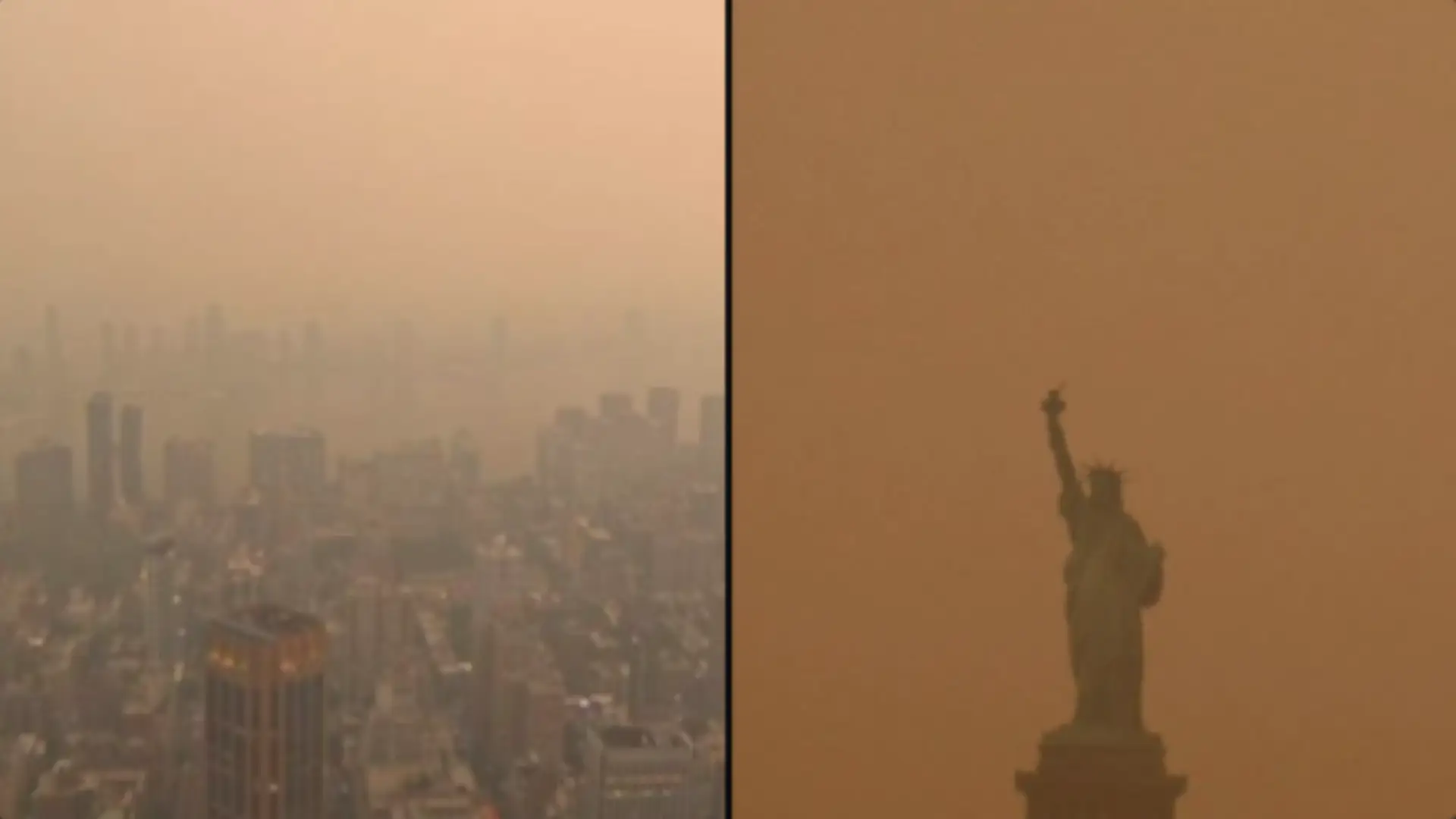Estimated reading time: 5 minutes
Canada Wildfire Smoke Brings New York City’s Air Quality to Dangerous Levels
New York City’s Air Quality Reaches Dangerous Levels as Smoke from Canadian Wildfires Brings Concerns
The city that never sleeps, New York City, found itself facing a silent threat on Tuesday as it topped the list of the world’s worst air pollution. Harmful smoke from over a hundred wildfires raging in Quebec, Canada, wafted south, blanketing the city and pushing its air quality to hazardous levels. The arrival of this dense smoke has raised significant concerns about the persistent poor air quality and its potential health consequences for the residents of the Big Apple.
Impact of Wildfires in Quebec on New York City’s Air Quality
For more than a week now, smoke originating from the wildfires in Canada has intermittently engulfed the Northeast and Mid-Atlantic regions. This unwelcome visitor from the north has resulted in a gradual deterioration of air quality, causing alarm among the affected communities.
New York City’s Air Quality Index Surpasses 200
On Tuesday night, the air quality index (AQI) in New York City soared above 200, reaching a level classified as “very unhealthy” by IQair, a renowned air quality monitoring organization. This unfortunate distinction placed the city at the top of the list for the worst air quality among major metropolitan areas. The situation was particularly concerning at 10 p.m. ET when New York City surpassed other cities and claimed the undesirable title.
Comparison with Other Cities on the List
As the night wore on, New York City’s air pollution levels briefly slid to the second-worst globally, trailing behind New Delhi, India. IQair reported that other cities such as Doha, Qatar; Baghdad, Iraq; and Lahore, Pakistan, were also grappling with severe air pollution during that time.
School Districts in Central New York Take Precautionary Measures
The alarming air quality situation prompted at least 10 school districts in central New York state to cancel outdoor activities and events on Tuesday. These precautionary measures encompassed a broad range of academic, athletic, and extracurricular events. Outdoor recess and gym classes were also canceled as school districts prioritized the well-being of their students and staff.
Understanding the Dangers of Wildfire Smoke
The smoke emanating from wildfires, including those in Quebec, carries a significant health risk due to the presence of extremely tiny particulate matter known as PM2.5. Despite its minuscule size, PM2.5 particles are the most hazardous pollutants as they can penetrate deep into lung tissue and even enter the bloodstream. Various sources contribute to the formation of PM2.5, including the combustion of fossil fuels, dust storms, and, in this case, wildfires. Exposure to PM2.5 has been linked to a multitude of health problems, including asthma, heart disease, and respiratory illnesses.
Millions of people worldwide succumb to air pollution-related health issues each year, emphasizing the gravity of the problem. According to the World Health Organization, approximately 4.2 million premature deaths in 2016 were attributed to fine particulate matter.
On Tuesday, the concentration of PM2.5 in New York City’s air exceeded the World Health Organization’s guidelines by more than tenfold. William Barrett, the national senior director of clean air advocacy with the American Lung Association, urged people to be aware that exposure to smoke occurs when it is visible or can be smelled. He emphasized the importance of remaining indoors during high pollution episodes and monitoring one’s health for the development of symptoms.
Barrett also highlighted specific groups that are particularly vulnerable to wildfire smoke, including children, senior citizens, pregnant individuals, and those with pre-existing respiratory or cardiovascular conditions. For these individuals, symptoms may worsen or new symptoms may emerge when exposed to smoke.
Conclusion
The alarming levels of air pollution in New York City caused by the smoke from Canadian wildfires necessitate immediate attention. The issue extends beyond borders, reminding us of the interconnectedness of environmental challenges. Awareness and collective actions are crucial in combating air pollution and its adverse effects on public health.
FAQs
1. How long has the smoke from Canadian wildfires been affecting the Northeast and Mid-Atlantic regions? The smoke from Canadian wildfires has been intermittently affecting the Northeast and Mid-Atlantic regions for over a week.
2. What was the air quality index (AQI) in New York City on Tuesday night? On Tuesday night, the AQI in New York City surpassed 200, reaching a level classified as “very unhealthy.”
3. Which cities topped the list of the world’s worst air pollution alongside New York City? New Delhi, India, Doha, Qatar, Baghdad, Iraq, and Lahore, Pakistan were among the cities that shared the unfortunate distinction of severe air pollution.
4. How does exposure to wildfire smoke affect health? Exposure to wildfire smoke, which contains PM2.5 particles, can lead to various health problems, including asthma, heart disease, and respiratory illnesses.
5. What measures were taken by school districts in central New York in response to the poor air quality? As a precautionary measure, at least 10 school districts in central New York state canceled outdoor activities, including academic, athletic, and extracurricular events, as well as outdoor recess and gym classes.
Table of contents
























